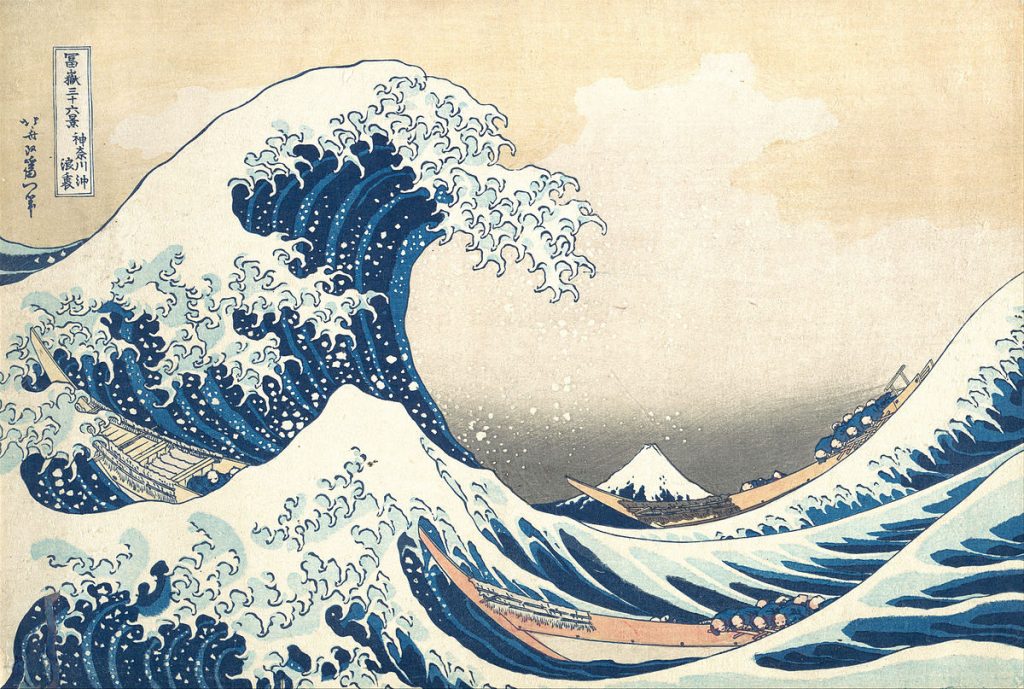What do you suppose would happen if Buddhism were to be brought to China, and then introduced to the samurai warriors of Japan? If you answered that Zen Buddhism would be created, then you’re correct. The Chinese, especially the Taoists, were intrigued by Buddhism’s profound philosophy, dialects, analyses, and speculations. However, Buddhism’s advocacy of a homeless life, world-fleeing, and life-denying tendencies did not mesh with the Chinese people’s worldly and practical centered lives.

Keeping with Buddhism’s made idea of achieving Nirvana, Zen focuses on achieving Satori (さとり) (enlightenment). Instead of focusing on escaping the cycle of rebirth, Zen focuses on finding meaning in everyday activities such as eating, working, and business etc. The meaning revealed to us is in being itself, or isness, often referred to in Japanese as kono-mama (この-まま) or sono-mama (この-まま). Another characteristic of Zen is that is does not deal with the abstract. A Zen-man will have no need for instruments of other media to express his art. Instead, upon achieving Satori (さとり), a Zen-man will become privy to a world of wonders and miracles 1, and his art will be expressed through the transformation of his life into a world of creation.2 Ultimately, a person will not escape the cycle of rebirth. Rather, they continue to be reborn so that they may help others achieve Satori (さとり) through Zen. The Chinese developed Zen as a form of Buddhism that focused more heavily on the physical and living world rather than a different one.
This explains how Zen came about but, how did it make its way to Japan? Japan and China had a big brother little brother relationship. China was the larger and more powerful country with a plethora of resources at its disposal, whereas Japan was an island nation that had limited resources available to itself. Because of this, Japan frequently traded goods and ideas with China. Through continuous trade, Japan would adopt many of China’s farming practices, its calendar system, and their written language, also known as Kanji. Even the Japanese government would import laws and other ideas from the Chinese government, even going so far as to send students and government officials to study from Chinese officials. Over time, Japan’s culture would become very similar to China’s own, by becoming much more focused on the living world rather than the afterlife. It was through this trade relationship that the twelfth-century Buddhist priest Eisai journeyed to China. Upon his return, Eisai brought with him Buddhism’s newest school of thought to Japan and began introducing Zen to the Kyoto area.3

However, Zen was not the first form of Buddhism introduced to Japan. While there is some debate over the exact time when Buddhism was first introduced to Japan, the most commonly agreed upon time frame is 500 to 550 C.E. Because the older schools of Buddhism were already well established in the Kyoto region, Zen struggled to gain popularity. Eisai was forced to take a conciliatory stance in relation to the older schools of Buddhism, and diplomatically garnered favor with the Imperial Court. After his peaceful attempts to spread Zen were met with violence, Eisai traveled back to the Kamakura region, home of the Hojo government (1200-1330). It was here in the Hojo government that Eisai was able to spread Zen to a wider audience.4
The Hojo Government was known for being a militaristic regime.5 The most well-known member of the Hojo family was Hojo Tokimune. Tokimune is widely considered one of Japan’s greatest historical figures for his successful quelling of the Mongol invasions. Tokimune was only thirty-two at the time of his death, but in his short life, Tokimune dedicated himself to the study of Zen and erected temples for the Chinese Zen masters in Japan. Due to his revered status and position in the Hojo regime, many of the lower ranking generals and samurai adopted Zen both as a way to honor their fallen leader and because living a Zen life was thought to be the way a samurai should live his life.

Zen has its strongest connection to the samurai through the famous Bushido Code, also known as the way of the warrior, which is the code samurai live their lives by. A samurai that follows the Bushido Code values loyalty, filial piety, and kindness above all else. However, to live this life, a samurai must clear his mind of all other distractions, including the fear of death. To be an infallible guardian that their masters expected them to be, a samurai had to only concern himself with living, or isness, and in doing so would find Zen and achieve Satori (さとり). For a samurai, living by the Bushido Code and being their master’s almighty guardian was best achieved through living a Zen life and achieving Satori (さとり). Funny how it was the blending of an Indian religion with Chinese ideas that helped the Japanese samurai live a life more in line with their warrior code.
- Ichirou Ishida and Delmer Brown, “Zen Buddhism and Muromachi Art, The Journal of Asian Studies, Vol. 22, No. 4 (Aug., 1963): 419 ↵
- Wm. Theodore de Bary, Donald Keene, George Tanabe, and Paul Varley, Sources of Japanese Tradition 2nd ed., vol. 1 (New York: Columbia University Press, 2001), 321-324. ↵
- Encyclopedia of Religion, 2005, s.v, “Buddhism: Buddhism In Japan,” by Brian O. Ruppert ↵
- E. Dale Saunders, Buddhism in Japan With an Outline of Its Origins in India (Great Britain, India, Pakistan: Oxford University Press London, Bombay, and Karachi, 1964), 94. ↵
- Daisetz T. Suzuki, Zen and Japanese Culture (New York: Pantheon Books Inc., 1960), 62. ↵



39 comments
Hector Garcia
This article seems to be well-researched and it looks like you put your time and effort to create this great article. It is interesting to see how Zen Buddhism was adopted by the samurai in Japan and how it became their warrior code. The article also mentions Satori, which means “sudden enlightenment”, and other aspects of the Zen Buddhism which seem interesting to a reader.
Johnanthony Hernandez
When I think of the Samurai, the Bushido Code comes to mind not Zen Buddhism. I knew that Buddhism had made its way from the mainland over to Japan via the frequent trading of goods that the two nations had. With your article being one of the few pieces that I have read on Zen Buddhism, I didn’t know that it was introduced around 500 to 550 C.E., or that the mixing of Indian religion and Chinese ideology would give the Samurai more of a reason to live.
Alyssa Childs
I find Buddhism very intriguing. I remember studying Buddhism in one of the most competitive classes I have ever been in, Academic Decathlon, in this class we got a different subject every year and one included the religion of Buddhism and how the goal of a Buddhist is to get enlightenment (Nirvana) and liberate oneself from endless reincarnation and suffering.
Nathan Hudson
Interesting, I had known so little about this subject, and you’re right it is funny how an Indian religion, that the Chinese became interested in, was the way that samurai followed their code better. This is an example of how ideas and culture spreads throughout areas that are close to one another. Nowadays, Buddhism, Zen, and many cultures around the world are widespread because of the connectivity of our lives.
Jacob Johnson
It is rather interesting how these two cultures could’ve created a belief that keeps the core ideals of Buddhism with a somewhat redirected purpose for those ideals. As they said Buddhism was originally intended to teach those who lived difficult lives to keep hope and live justly, because something better would await them in their next life. Yet Zen Buddhism seems to teach the same ideals, but with the intent of people using these ideals to improve their current lives. I find it both strange and interesting, and I respect both aspects.
Seth Castillo
Buddhism is very interesting because one would have to disconnect from a lot of things. A Buddhist should not be very materialistic. It’s crazy to think that one should not value materials very much especially now since its difficult for younger people to not treat their phones like their offspring. Buddhism is just interesting to me personally because it’s so very different from the conventional religions in America.
Natalia Carroll-Long
Considering how important Samurais were to Japan at the time it’s very interesting to see their mindset and what they believed. Personally, I think it’s great when cultures intertwine and this is an example. Your article was well thought out and focuses on the main goals of Zen Buddhism. It’s interesting to think that people could get rid of their worldly possessions, but it works well with the Samurai considering their main goal is to protect their people.
Elias Garza
Personally, I have always been interested in Buddhism but never practiced it myself. Although I am a loyal person and overall kind, I do not think I would be able to convert to Buddhism. However, the part of this article that grabbed my attention the most was when the author started talking about the Bushido Codes. The amount of loyalty and faith it takes to live life the way they do is fulfilling.
Clayton Trevino
Despite originating in Northeastern India in sixth century B. C., Buddhism is still practiced by more than 300 million individuals worldwide. Although I’ve never practiced Buddhism or meditated regularly, I have been exposed to it through modern pop culture icons. One of the most popular science fiction works of all time, the Star Wars franchise, clearly takes heavy influence from Zen Buddhism and the culture taught by the Bushido and practiced by the samurai.